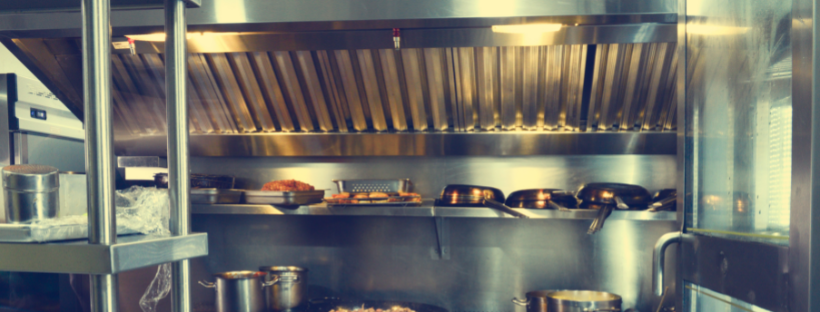You’ve probably heard before that exhaust hood systems are one of the most important parts of a restaurant kitchen. They pull smoke, heat and odor up from cooking surfaces, into the hood, and then exhaust it to the outside. Not only does this protect employees and make the kitchen more comfortable, it also protects the restaurant facility. While the ventilation hood does help remove these contaminants, some of them do end up stuck inside the hoods and the ductwork in the form of grease, oil, and even creosote buildup. And this buildup can lead to potentially dangerous situations. That’s why exhaust hood cleaning is so crucial to every restaurant ventilation system. Read on to learn more about vent hood cleaning tips for commercial kitchens and restaurants.
How to Protect Your Exhaust Hood Against Fire Hazards?
Grease, fats, and oils can build-up inside your hood and duct system. The risk of fire when this happens has made grease build-up one of the leading causes of restaurant kitchen fires. Thankfully, protecting against fire hazards in your hood system is very straightforward. With proper maintenance and cleaning, you can drastically reduce the risk. Simply put, regular and thorough cleanings of your exhaust hood, hood filters, and ductwork, make your restaurant ventilation not only cleaner, but safer.
Exhaust Hood Cleaning Requirements
The National Fire Protection Agency (NFPA) sets forth national requirements for professional exhaust hood cleaning in commercial kitchens and restaurants. Failure to meet these requirements does more than increase the risk of fire; it also puts the restaurant at risk for hefty fines and even mandatory closure. Exhaust hood cleaning requirements and best practices are outlined in NFPA 96, including the frequency of cleaning by trained, certified kitchen exhaust cleaning professionals.

Exhaust Hood Cleaning Guidelines
Here are the guidelines for various types of commercial cooking facilities:
Monthly Cleaning – Systems serving solid fuel cooking operations
Quarterly Cleaning – Systems serving high-volume operations, such as 24-hour cooking, charbroiling, wok cooking, etc.
Semi-Annual Cleaning– Systems serving moderate volume cooking operations
Annual Cleaning – Systems serving low volume cooking operations, such as day camps, churches, seasonal businesses, etc.
To be considered thorough, exhaust hood cleaning should include:
- Disassembly, cleaning, and degreasing of hoods, including hood filter tracts, grease troughs, and any removable grease cups
- Removal of the roof and/or wall mounted upblast exhaust fans from the ductwork to degrease the base, shroud, and blades
- Inspecting of exhaust fans for any loose or worn out fan belts
- Cleaning and degreasing all grease baffle hood filters, hood parts and accessories, and replacing if necessary
- Cleaning all accessible parts of the grease ductwork from upblast exhaust fans to each individual exhaust hood
- Applying food-safe polish to any stainless steel ductwork
- Thoroughly cleaning all affected areas in the facility (remove plastic, mop, remove any debris, etc.)
- Providing a complete, detailed written report of all work performed, and any deficiencies noted in the exhaust hood system, as well as recommendations for addressing any problems
- Attaching a certificate showing the company name, the person performing the work, and the date of cleaning to each exhaust hood that was cleaned
The Role of Duct Access Doors in Exhaust Hood Cleaning
Grease duct access doors give professional hood cleaners the access they need to perform a thorough “top to bottom” cleaning of the restaurant ventilation and exhaust systems. They are basically metal panels designed to provide access to the interior surface of your ventilation ductwork. They are often overlooked and under appreciated, but duct access doors are an essential restaurant ventilation accessory. Duct access panels must also be grease tight and rated for up to 1500 degrees at a minimum. Properly installing duct access doors in your restaurant ventilation system is critical when it comes to professional hood cleaners getting your hood system clean of all fat, oil, and grease.
Watch this short video on the importance of installing duct access doors:
The Role of Professional Exhaust Hood Cleaners
Using a certified professional hood cleaner is a necessity for most commercial cooking operations, both to reduce the risk of fire and to avoid noncompliance. They offer an in-depth understanding of NFPA 96 requirements, can help restaurant owners and managers make sure their restaurant ventilation is functioning properly, and ensure that it’s meeting any compliance standards. If you have questions, reputable hood cleaners are usually more than happy to walk you through their hood cleaning procedures before performing any work.
A Few Last Words
Keeping your ventilation system clean will reduce the risk of fire at your restaurant and commercial kitchen. And a big part of keeping your hood and exhaust fan clean is using the right grease hood filter. After all, the more grease and smoke you keep from entering into your exhaust hood, the less you will need to have cleaned from it. Need some expert information on vent hoods, grease filters, or maybe some hood cleaning and power washing supplies so you can take care of cleaning your exhaust hood on your own? HoodFilters.com has you covered! Just give us a call at 877-394-9731 or send an email to customerservice@hoodfilters.com. You can even live chat with us online. Or if you are ready to shop, just head on over to HoodFilters.com and see our full selection of restaurant ventilation supplies. And remember, our product specialists are always here to help you with any questions!
